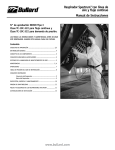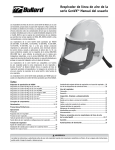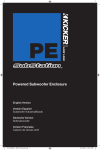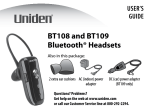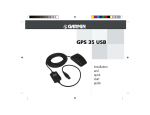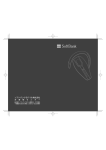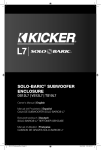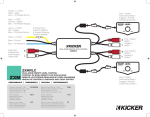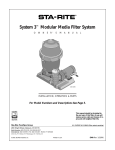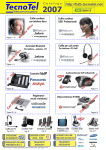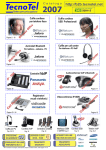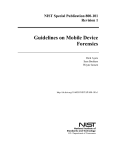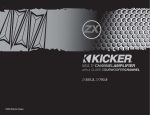Download Spectrum™ Continuous Flow Airline Respirator Instruction Manual
Transcript
Spectrum™ Continuous Flow Airline Respirator Instruction Manual Type C NIOSH Approval No. TC-19C-322 Continuous-Flow Class and TC-19C-321 Pressure-Demand Class. READ ALL INSTRUCTIONS AND WARNINGS BEFORE USING THIS RESPIRATOR. SAVE THIS MANUAL FOR FUTURE USE. Table of Contents APPROVAL LABELS ...................................................................................2,3 GENERAL INFORMATION................................................................................. 4 COMPONENT CONCEPT....................................................................................4 MASK/FITTING ASSEMBLIES.......................................................................... 5 AIR SUPPLY HOSE OPTIONS........................................................................... 5 WARNINGS ................................................................................ 5, 6 OPERATIONS .....................................................................................7 BREATHING AIR PRESSURE TABLE.................................................................. 8 RESPIRATOR ASSEMBLY Putting Respirator On.......................................................................9 Taking Respirator Off........................................................................9 INSPECTION, CLEANING AND STORAGE...................................................... 10 FIT TESTING ................................................................................... 11 PARTS AND ACCESSORIES FOR SPECTRUM RESPIRATORS............................................................. 11 RETURN AUTHORIZATIONS........................................................................... 12 www.bullard.com SA/CF 19C-322 M45-CF-ML SPEC-CF-ML SPEC-CF-S X X X X M45-CF-S www.bullard.com B102 B100 B101 B135 BT100 BT108 BT102 BT101 BT135 X X X X X X X X X X X 5454 3 Alternate Hoses X 100’ 100’ 25’ 50’ 25’ 50’ (7.6 M) (15.2 M) (30.5 M) (7.6 M) (15.2 M) (30.5 M) 5457 Flow Control Device X 5458 X X X Spectacle Kit X PL Anti-Fog Lens Wipe X AFW45 Lens Cover X LC Accessories Nose Cup X X X X X LNK 45PL 45LC SNA45 AMP Amplifier B. Not for use in atmospheres immediately dangerous to life or health. C. Do not exceed maximum use concentrations established by regulatory standards. D. Air-line respirators can be used only when the respirators are supplied with respirable air meeting the requirements of CGA G-7.1 Grade D or higher quality. E. Use only the pressure ranges and hose lengths specified in the User’s Instructions. J. Failure to properly use and maintain this product could result in injury or death. M. All approved respirators shall be selected, fitted, used and maintained in accordance with MSHA, OSHA and other applicable regulations. N. Never substitute, modify, add or omit parts. Use only exact replacement parts in the configuration specified by the manufacturer. O. Refer to User’s Instructions, and/or maintenance manuals for information on use and maintenance of these respirators. 2. CAUTIONS & LIMITATIONS 1. PROTECTION SA-SUPPLIED AIR CF-CONTINUOUS FLOW Protection1 TC# B108 Respirator Components 4696 Spectacle Kit 2 V2050ST Lens Cover 1 Alternate Facepiece V20100ST Small Nose Cup Approved only in the following configurations: Coupler Assemblies X CA30 Spectrum-CF Type C Continuous Flow, Supplied Air Respirator X CA31 Spectrum Series Bullard 1898 Safety Way Cynthiana, Kentucky 41031 800-827-0423 X CA32 Approval Labels X CA38 2 Cautions & Limitations 2 Approval Labels www.bullard.com SPEC-CF-S X X X X SPEC-CF-ML 2 BT135 X B135 X X X 100’ 50’ (15.2 M) (30.5 M) 3 Alternate Hoses Spectacle Kit X PL Anti-Fog Lens Wipe X AFW45 Lens Cover X LC Accessories X X LNK 45PL X Small Nose Cup X X SNA45 AMP Amplifier Cautions & Limitations 2 B. Not for use in atmospheres immediately dangerous to life or health. C. Do not exceed maximum use concentrations established by regulatory standards. D. Air-line respirators can be used only when the respirators are supplied with respirable air meeting the requirements of CGA G-7.1 Grade D or higher quality. E. Use only the pressure ranges and hose lengths specified in the User’s Instructions. J. Failure to properly use and maintain this product could result in injury or death. M. All approved respirators shall be selected, fitted, used and maintained in accordance with MSHA, OSHA and other applicable regulations. N. Never substitute, modify, add or omit parts. Use only exact replacement parts in the configuration specified by the manufacturer. O. Refer to User’s Instructions, and/or maintenance manuals for information on use and maintenance of these respirators. 2. CAUTIONS & LIMITATIONS 1. PROTECTION SA-SUPPLIED AIR PD-PRESSURE DEMAND SA/PD M45-CF-S Alternate Facepiece M45-CF-ML Protection1 V2050ST Nose Cup TC# V20100ST Spectacle Kit Respirator Components Lens Cover Approved only in the following configurations: Spectrum-CF-P Type C Pressure Demand, Supplied Air Respirator Spectrum Series Bullard 1898 Safety Way Cynthiana, Kentucky 41031 800-827-0423 Spectrum™ Continuous Flow Airline Respirator Instruction Manual 3 GENERAL INFORMATION Bullard’s Spectrum-CF airline respirator, when properly used, provides a continuous flow of air from a remote air source to the respirator wearer. Spectrum-CF respirators offer protection from airborne contaminants that are not immediately dangerous to life or health (IDLH), or that do not exceed concentrations allowed by applicable OSHA, EPA, NIOSH or ACGIH regulations and recommendations for continuous-flow or pressure-demand class airline respirators. Spectrum-cf respirators are compatible with breathing air sources such as air compressors or Bullard Free-Air® Pumps. Bullard offers the appropriate approved breathing tube assembly and air supply hose to connect the Spectrum-CF respirator to these breathing air sources. This respirator is available in two mask sizes. A probed mask kit is available for quantitative fit testing. Contact Bullard or our local authorized distributor for more information about other accessories for Spectrum-CF respirators. Spectrum-CF airline respirators are approved by NIOSH (TC-19C-322 Type C, Continuous-Flow Class and TC-19C-321, Pressure-Demand Class) to provide respiratory protection in general purpose applications, including spray painting, tank cleaning, chemical and pesticide handling, and other industrial or agricultural applications. The Spectrum-CF is NOT to be used in confined spaces or in IDLH conditions. COMPONENT CONCEPT The Spectrum-CF airline respirator consists of three components: full-face mask, breathing tube assembly and air supply hose. All must be present and properly assembled to constitute a complete NIOSH approved respirator. 1. Full-Face Mask with Headstrap. 2. Breathing Tube Assembly 3. Air Supply Hose General Information / Component Concept ➊ 4 ➋ ➌ Figure 1 Clean Breathable Air Source Supplying Grade “D” or Higher Air Quality (See Breathing Air Requirements on page 8) � WARNING Failure to use complete NIOSH-approved Bullard components and replacement parts voids approval of entire assembly. Basic parts are listed on the NIOSH Approval Label on Pages 1 and 2. www.bullard.com Spectrum™ Continuous Flow Airline Respirator Instruction Manual MASK/FITTING ASSEMBLIES FULL-FACE MASK RESPIRATOR WITH BREATHING TUBE ASSEMBLY: Comfortable silicone full-face mask with breathing tube that connects the mask to air supply hose. For use with breathing air compressors/continuous flow or pressure demand spec40, 1/4” Industrial Interchange For use with ambient air pumps/continuous flow or pressure demand SPEC35, 1/2” Industrial Interchange SPEC41, 1/4” Schrader SPEC42, 1/4” Snap-Tite SPEC48, 1/4” Bayonet AIR SUPPLY HOSE OPTIONS Connects breathing tube to air source supplying clean breathable air. Hose for High Pressure Compressed Air Source Hose for Low Pressure Ambient Air Source V10 3/8” I.D. Hose V20 1/2” I.D. Hose 4696 Starter Hose 545 Series Extension Hose V20 Starter/ Extension Hose Extension hose available in 25, 50 and 100 foot lengths with a variety of quick-disconnect fittings, styles and materials. See parts list for details. Available in 50 and 100 foot lengths with a variety of quick-disconnect fittings, styles and materials. See parts list for details. 2. Before using this respirator, be sure your employer has determined that airborne contaminant concentrations do not exceed those allowed by applicable OSHA, MSHA, EPA, NIOSH or ACGIH regulations and recommendations, or any other applicable regulations for continuous-flow airline and pressuredemand airline respirators. Federal law requires that your employer measure and monitor airborne contaminant levels in the work area. 3. Improper respirator use may damage your health and/or cause your death. Improper use may also cause certain life-threatening delayed lung diseases such as silicosis, pneumoconiosis or asbestosis. 4. DO NOT wear this respirator if any of the following conditions exist: - Atmosphere is immediately dangerous to your life or health (IDLH). - You CANNOT escape without the aid of the respirator. - Atmosphere contains less than 19.5% oxygen. - Work area is poorly ventilated. - Unknown contaminants are present. - Contaminant concentrations are in excess of regulations or recommendations (as described in item 2 above). 5. Bullard recommends that you DO NOT wear this respirator until you have passed a complete physical exam (perhaps including a lung x-ray), conducted by qualified medical personnel, and have been trained in the respirator’s use, maintenance and limitations by a qualified individual (appointed by your employer) who has extensive knowledge of the Bullard Spectrum respirator. www.bullard.com Mask/Fitting Assemblies / Air Supply Hose Options � WARNING 1. This respirator, when properly fitted and used, significantly reduces, but does not completely eliminate, the breathing of contaminants by the respirator wearer. You may obtain better respiratory protection from other types of respiratory protection equipment such as a valve-operated pressure-demand airline respirator or a pressure-demand self-contained breathing apparatus respirator. 5 � WARNING 6. DO NOT modify or alter this respirator in any manner. Use only NIOSH approved Bullard Spectrum components and replacement parts manufactured by Bullard for use with this respirator. Failure to use NIOSH approved components and replacement parts such as hoses and flow-control devices, voids NIOSH approval of the entire respirator, invalidates all Bullard warranties, and may cause death, lung disease or exposure to other hazardous or lifethreatening conditions. 7. Inspect all components of this respirator system daily for signs of wear, tear or damage that might reduce the degree of protection originally provided. Immediately replace worn or damaged components with NIOSH approved Bullard Spectrum components or remove respirator from service. (See INSPECTION, CLEANING AND STORAGE section for proper maintenance of the Spectrum respirator.) 8. Be certain your employer has determined that the breathing air source provides at least Grade D breathable air. This respirator must be supplied with clean breathable air at all times. 9. DO NOT connect the respirator’s air supply hose to nitrogen, oxygen, toxic gases, inert gases or other unbreathable, non-Grade D air sources. To prevent this, airline couplings used for this respirator shall be incompatible with outlet for other gas systems. Check the air source before using the respirator. Failure to connect to the proper air source may result in serious injury or your death. 10. DO NOT use this respirator in poorly ventilated areas or confined spaces such as tanks, small rooms, tunnels or vessels, unless the confined space is well ventilated and contaminant concentrations are below the upper limit recommended for this respirator. In addition, follow all procedures for confined space entry, operation and exit as defined in applicable regulations and standards, including 29 CFR 1910.146. 11. If you have any questions concerning the use of this respirator, or if you are not sure whether the atmosphere you are working in is immediately dangerous to life or health (IDLH), ask your employer. All instructions for the use and care of this product must be supplied to you by your employer as recommended by the manufacturer and as required by Federal Law (29 CFR 1910.134). 12. DO NOT use this respirator for abrasive blasting or underwater diving. cautions and limitations Warnings / Cautions and Limitations B. Not for use in atmospheres immediately dangerous to life or health. C. Do not exceed maximum use concentrations established by regulatory standards. D. Air-line respirators can be used only when the respirators are supplied with respirable air meeting the requirements of CGA G-7.1 Grade D or higher quality. E. Use only the pressure ranges and hose lengths specified in the User’s Instructions. J. Failure to properly use and maintain this product could result in injury or death. M. All approved respirators shall be selected, fitted, used and maintained in accordance with MSHA, OSHA and other applicable regulations. N. Never substitute, modify, add or omit parts. Use only exact replacement parts in the configuration specified by the manufacturer. O. Refer to User’s Instructions, and/or maintenance manuals for information on use and maintenance of these respirators. For technical assistance, call or write: 6 Bullard 1898 Safety Way Cynthiana, KY 41031-9303 Toll-Free: 800-827-0423 Phone: 859-234-6611 Facsimile: 859-234-6858 www.bullard.com Spectrum™ Continuous Flow Airline Respirator Instruction Manual OPERATIONS The requirements for Grade D breathable air include: Limitations of Use RESPIRATORY This respirator is NIOSH approved (TC-19C-322, continuous-flow class and TC-19C-321, pressure-demand class) for Type C applications. It can be worn for general purposes including: spray painting; tank cleaning; chemical and pesticide handling; and other industrial or agricultural applications. This respirator is not approved for use in any atmosphere immediately dangerous to life or health (IDLH), or from which the wearer cannot escape without the aid of the respirator. This respirator is not approved for abrasive blasting. HEAD Spectrum respirators DO NOT provide head protection. Wear approved head protection if head protection is required. FACE This respirator’s lens meets ANSI Z87.1-1989 faceshield requirements for impact, penetration and optics. The lens provides LIMITED FACE PROTECTION. The Spectrum lens is not shatterproof. EYES Spectrum respirators provide LIMITED eye protection from flying particles and splash per ANSI Z87.1979. Primary eye protection should be worn when necessary. Point-ofAttachment Pressure Gauge -Oxygen................................................. 19.5-23.5% -Hydrocarbons (condensed) in mg/m3 of gas.......................5 mg/m3 max. -Carbon monoxide...............................10 ppm max. -Carbon dioxide..............................1,000 ppm max. -Odor................................ lack of noticeable odor* -No toxic contaminants at levels that make air unsafe to breathe. *Specific measurement of odor in gaseous air is impractical. Air may normally have a slight odor. The presence of a pronounced odor should render the air unsatisfactory. Contact the Compressed Gas Association (1725 Jefferson Davis Highway, Arlington, VA 22202) for complete details on commodity Specifications G-7.1 AIR SOURCE Locate the source of supplied air, whether it is an air compressor or an ambient air pump, such as a Bullard Free-Air® pump, in a clean air environment. Locate the air source far enough from your work site to ensure the air remains contaminant-free. Always use an inlet filter on the air source. Use suitable after-cooler/dryers with filters, and carbon monoxide monitors and alarms, like Bullard’s Alert-1™ CO monitor, as necessary to assure clean, breathable air at all times. The air should be regularly sampled to be sure that it meets Grade D requirements. Breathing Air Pressure Air pressure must be continually monitored at the point-of-attachment while operating this respirator. A reliable air pressure gauge must be present to permit you to continually monitor pressure during actual respirator operation. Respirator � WARNING Air Supply Hose Figure 2 Grade D Breathable Air Source Breathing Air Requirements AIR QUALITY � WARNING This respirator MUST be supplied with clean, breathable air, Grade D or better, at all times. This respirator does NOT purify air or filter out contaminants. Respirable, breathable air must be supplied to the point-of-attachment of the approved Bullard air supply hose. The point-of-attachment is the point at which the air supply hose connects to the air source. A pressure gauge attached to the air source is used to monitor the pressure of air provided to the respirator wearer (See Figure 2). The Breathing Air Pressure Tables (See page 10) define the air pressure ranges necessary to provide Spectrum-CF respirators with a volume of air that falls within the required range of 4-15 cfm (Ref. 42 CFR, Part 84, Subpart J.84.150) when operated in continuous-flow mode. Meets pressure-demand class requirements when operated within the pressure ranges listed in Table 2 (Ref. 42 CFR 84.157). Make sure you understand the information in the Breathing Air Pressure Table (see page 10) before using this respirator. 1. Determine the type of air source you are using (column 1), then find the breathing tube assembly (column 2). 2. Be sure your Bullard air supply hose(s) (column 3) is approved for use with your breathing tube assembly. 3. Determine that your Bullard air supply hose is within the approved length (column 4). 4. Make sure you have not exceeded the maximum number of hose sections (column 5). 5. Set the air pressure at the point-of-attachment within the required pressure range (column 6) for your breathing tube assembly and air supply hose type and length. Accurate pressure readings can only be attained when air is flowing into the respirator. www.bullard.com Operations Supplied breathing air must AT a minimum meet the requirements for Type 1 gaseous air described in the Compressed Gas Association Commodity Specification G-7.1 (Grade D or higher quality), as specified by Federal Regulations 42 CFR, Part 84.141 (b) and 29 CFR 1910.134 (i). Failure to supply the minimum required pressure at the pointof-attachment for your hose length and type will reduce airflow and may Cause injury, disease or death. 7 Breathing Air Supply Hoses and Hose Fittings NIOSH-approved Bullard air supply hose(s) MUST be used between the breathing tube connection fitting on the wearer’s belt and the point-of-attachment to the air supply (see Figure 1). NIOSH-approved Bullard quick-disconnect fittings MUST be used to connect V20 hose lengths together. When connecting lengths of V10 hose, only use Bullard V11 hose-to-hose adaptors. Secure connection(s) until wrench-tight and leak-free. Total connected hose length and number of hoses MUST be within the ranges specified on the Breathing Air Pressure Table (see page 10) and the respirator’s NIOSH approval labels (see pages 1 and 2). The breathing tube connection fitting MUST be secured to the belt that is supplied with this respirator. Securing the air entry connection fitting helps prevent the air supply hose from snagging, disconnecting or pulling the respirator off your face. Breathing Air Pressure Table Continuous-Flow Class This table defines the air pressure ranges necessary to provide Spectrum-CF Series respirators with a volume of air that falls within the required range of 4-15 cfm according to U.S. Government regulations (Ref. 42 CFR 84.150). 1 2 3 4 5 6 Air Source Breathing Tube Assembly Air Supply Hose Air Supply Hose Length (Feet) Maximum Number of Hose Sections Required Pressure Range (psig air) Stationary or portable air compressor BT100, BT101, BT102, BT108 V10 25-50 100-150 200-300 2 3 5 29-57 33-62 37-65 Bullard Free-Air® Pumps BT135 V20 25-50 100-150 250-300 2 3 3 6-18 8-22 10-27 Pressure-Demand Class This table defines the air pressure ranges necessary to provide Spectrum-CFP Series respirators with a volume of air that meets the pressure-demand requirements according to U.S. Government regulations (Ref. 42 CFR 84.157). 2 3 4 5 6 Air Source Breathing Tube Assembly Air Supply Hose Air Supply Hose Length (Feet) Maximum Number of Hose Sections Required Pressure Range (psig air) Bullard Free-Air® Pumps BT135 V20 25-50 100-150 250-300 2 3 3 9-10 11-12 13-14 Breathing Air Pressure Tables 1 8 www.bullard.com Spectrum™ Continuous Flow Airline Respirator Instruction Manual SPECTRUM RESPIRATOR ASSEMBLY Putting Respirator On 11. Adjust the air pressure at the “point-of-attachment” to within the approved pressure range. See the Breathing Air Pressure Table on page 10 for the approved pressure range. 1. Remove the Spectrum-CF respirator from the plastic shipping bag. Except for the belt, the respirator is shipped completely assembled. Lace the belt through the metal slide or adjustable-flow control fitting that is attached at the end of the breathing tube. Do not wear this respirator without the belt. 2. Connect the NIOSH-approved Bullard air supply hose to the air source supplying Grade D breathing air. Clear the air supply hose by moving air through it for a few minutes before connecting it to the quick-disconnect fitting at the end of the air entry hose. 3. Fasten the belt at your waist or hip level and adjust for comfort. 12. With the air flowing into your respirator, you are now ready to enter the work area. Mask 1. When finished working, leave the work area wearing the respirator and with the air still flowing. 2. Once completely outside the contaminated area, remove the respirator by lifting the tabs on the latches. Disconnect the air supply hose using the quick-disconnect coupling. The mask cover must be used when operating this respirator. This part protects the exhalation valve from outside interference. Taking Respirator Off NOTE: If using V20 Series (1/2” I.D.) air supply hose, the quick-disconnect coupler does not have a shut off valve. Therefore, the air will continue to flow freely after it has been disconnected from the respirator. Figure 5 � WARNING If you cannot OBtain A proper fit, try another mask size and go through the same steps outlined above. if a proper fit is still not achieved, 10. With the air flowing, connect the quick-disconnect fitting on the respirator’s air entry hose to the quick-disconnect coupler on the air supply hose (See Figure 6). Once fitting is secured, release coupling sleeve to lock fitting together. Pull on both hoses to make sure they are attached securely. Figure 6 www.bullard.com Spectrum Respirator Assembly 4. Release the headstraps to the full outward position by pulling the headstrap quick release tabs forward. When fully extended, tabs should be located at the Figure 3 headstrap latches. 5. Grasp the headstrap harness with thumbs through the straps. Spread outward. 6. Push the top of the facepiece flange up the forehead, brushing hair upward from the face seal area (See Figure 3). Continue up and over the head until the harness is centered at the rear of the head, and the chin rests in the chin cup. 7. Pull both lower straps at the same time towards the rear (See Figure 4). Tighten the two temple straps. Tighten the top head strap if necessary. 8. Adjust headstraps until the facepiece fits securely and evenly. 9. Perform a negative pressure fit check: A) With facepiece on and secured, place your finger over the quick-disconnect nipple located at the end of the breathing tube (See Figure 5). B) Inhale until the mask collapses Figure 4 inward slightly (indicating there is negative pressure). Hold your breath for five seconds. C) The mask is deemed to be in proper position if it remained collapsed while the breath was held, and no inward leakage of outside air was detected. D) If the mask doesn’t collapse or if an inward leak is detected, re-adjust mask on face and repeat above steps until the test is passed. � WARNING 9 CONTAMINANTS. � WARNING LEAVE WORK AREA IMMEDIATELY IF: - Any respirator component becomes damaged. - Airflow into respirator stops or slows down. - Air pressure gauge drops below the minimum specified in Breathing Air Pressure Table (page 10). - Breathing becomes difficult. - You become dizzy, nauseous, too hot, too cold or ill. - You taste, smell or see contaminants inside respirator facepiece. - Your vision becomes impaired. � WARNING IN a contaminated ENVIRONMENT. Respirable contaminants can remain suspended in air for more than one hour after work activity ceases, even though you may not see them. Proper work practice requires you to wear the respirator until you are outside the contaminated area. If you set the respirator down in a contaminated environment, contaminants, dirt and dust could get into the respirator. When you put the respirator back on, you CoUld breathe in contaminants UPON REUSE. INSPECTION, CLEANING AND STORAGE This respirator and all of its component parts and assemblies should be inspected for damage or excessive wear before and after each use to ensure proper functioning. Immediately remove the respirator from service and replace parts or assemblies that show any sign of failure or excessive wear that might reduce the degree of protection. Use only complete NIOSH-approved Bullard Spectrum-CF components and replacement parts on this respirator. Refer to the parts list for correct part numbers. The respirator should be cleaned, inspected and sanitized at least weekly or more often if subjected to heavy use. Respirators used by more than one person must be cleaned, inspected and sanitized after each use. If not cleaned, contamination may cause illness or disease. REMEMBER, THE AIR YOU BREATHE WILL NOT BE CLEAN UNLESS THE RESPIRATOR YOU WEAR IS CLEAN. Inspection Cleaning and Storage Mask 10 Immerse the facepiece in warm water (about 120 degrees F) with mild detergent or a germicidal disinfecting detergent. The respirator body and parts may be scrubbed gently with a cloth or soft brush. All foreign matter must be removed carefully from all surfaces of the exhalation valve flap and seat. Rinse the respirator in clean, warm water (about 120 degrees F). Shake to remove excess water, and allow to air-dry away from direct heat, sunlight or contaminants. Breathing Tube Inspection: Inspect the breathing tube for tears, cracks, holes or excessive wear that might reduce the degree of protection originally provided. Be sure the quick-disconnect fitting is screwed tightly into the breathing tube so no air can escape. If any signs of excessive wear are present, replace the breathing tube assembly immediately or remove the respirator from service. Cleaning: Hand-sponge breathing tube with warm water and mild detergent, rinse and air-dry. Do not get water inside the breathing tube. After cleaning, once again carefully inspect breathing tube for signs of damage. Air Supply Hose Inspection: The hose(s) should be inspected closely for abrasions, corrosion, cuts, cracks and blistering. Make sure the hose fittings are crimped tightly to the hose so that air cannot escape. Make sure the hose has not been kinked or crushed by any equipment that may have rolled over it. If any of the above signs are present or any other signs of excessive wear are detected, replace the air supply hose(s) immediately or remove the respirator from service. Cleaning: The air supply hose(s) should be hand-sponged with warm water and mild detergent, rinsed and air-dried. Do not get water inside the air supply hose. After cleaning, once again carefully inspect air supply hose(s) for signs of damage. � WARNING Only use hoses that are approved by NIOSH for use with this respirator. Other hoses could reduce airflow and protection, and expose the wearer to life-threatening conditions. Storage After reusable respirator components have been cleaned and inspected, place them in a clean plastic bag or an airtight container. Store the respirator and parts where they will be protected from contamination, distortion and damage from elements such as dust, direct sunlight, heat, extreme cold, excessive moisture and harmful chemicals. Store the respirator so it is protected from distortion from the weight or pressure of surrounding objects. Wipe any areas still showing accumulations of foreign matter with a cloth moistened in a detergent or a solvent such as mineral spirits or naphtha, until clean. Stubborn accumulations of paints, lacquers or enamels may be removed with a cloth containing a paint, enamel or lacquer stripping agent. Once the dirt or paint is loosened, it may be gently rubbed or brushed off.DO NOT USE VOLATILE SOLVENTS FOR CLEANING THIS RESPIRATOR OR ANY PARTS OR ASSEMBLIES. STRONG CLEANING AND DISINFECTING AGENTS, AND MANY SOLVENTS, CAN DAMAGE THE SILICONE RUBBER AND PLASTIC PARTS. DO NOT LEAVE SOLVENTS AND STRONG CLEANING AND SANITIZING AGENTS IN CONTACT WITH SILICONE RUBBER OR PLASTIC SURFACES ANY LONGER THAN NECESSARY TO LOOSEN THE ACCUMULATIONS OF DIRT OR www.bullard.com Spectrum™ Continuous Flow Airline Respirator Instruction Manual fit testing According to Osha’s revised Respiratory Standard, 29 CFR 1910.134, all tight-fitting facepieces must now be fit tested, regardless of the mode of operation. This includes all respirator models in the Spectrum Series. Users must pass either a qualitative or quantitative fit test, and fit testing must be performed in the negative pressure mode. Bullard’s QNFT45 fit test kit converts the Spectrum facepiece to the negative pressure mode, and can be used for either type of fit testing. The instruction sheet that accompanies the kit provides guidance on its proper use. The options for qualitative challenge agents include: isoamyl acetate (banana oil), irritant smoke, saccharin and Bitrex (denatonium benzoate). Quantitative options include generated aerosol (like the fit test chamber in Bullard’s lab), ambient aerosol CNC (Portacount method), or controlled negative pressure (Dynatech Nevada Fit Tester 3000 method). The minimum fit factor for a fullface respirator is 500. The qualitative fit test protocols that had existed in the substance-specific standards (except Bitrex, which is new) have been updated in the revised standard with minor changes and will now be used for all substances. Fit testing shall be performed prior to initial use, whenever a different respirator is used, and at least annually thereafter. An additional fit test must also be performed whenever there are changes in the employee’s physical condition that could affect respirator fit, such as dental changes or an obvious change in body weight. PARTS AND ACCESSORIES FOR spectrum RESPIRATORs Cat. No. Description 4. ACCESSORIES AND KITS 1. RESPIRATOR ASSEMBLIES facepiece component replacement parts QNFT45Quantitative Fit Test Kit – Includes fir test adapter, facepiece, sampling adapter, 1/8” barbed mask probe and HEPA filter cartridge LCKLens Clamp Replacement Kit – Includes upper and lower clamps with screws and nuts RLS Lens replacement FK-LMedium/large facepiece flange FK-S Small facepiece flange HSKIncludes headstrap with 5 buckles and 5 slides MCK Includes mask cover SEKIncludes speaker diaphragm , outer locking ring, o-ring for speaker diaphragm, o-ring for speaker/exhalation body and speaker/exhalation body EVOIncludes exhalation valve seat, o-ring for exhalation valve seat LNKIncludes nosecup and 2 inhalation valve flaps Includes headstrap, breathing tube assembly with flow control device and nylon belt. For use with breathing air compressors or breathing air cylinders SPEC40LMedium/Large Spectrum Full-Face Mask with adjustable flow valve. SPEC40SSmall Spectrum Full-Face Mask with adjustable flow valve. For use with Bullard Free-Air pumps SPEC35LMedium/Large Spectrum Full-Face Mask with constant flow valve. SPEC35SSmall Spectrum Full-Face Mask with constant flow valve. 2. BREATHING TUBE ASSEMBLIES For use with breathing air compressors or breathing air cylinders BT100 Breathing tube assembly with 1/4” Industrial Interchange fitting, flow control device and nylon belt. BT101 Breathing tube assembly with 1/4” Schrader fitting, flow control device and nylon belt. BT102 Breathing tube assembly with 1/4” Snaptite fitting, flow control device and nylon belt. For use with Bullard Free-Air pumps BT135 Breathing tube with 1/2” Industrial Interchange fitting and nylon belt. 3. BREATHING AIR SUPPLY HOSES V10 Series Starter Hose Kit. Includes V1025ST hose with 1/4” Industrial Interchange quick-disconnect coupler and V13 adaptor fitting (3/8” hose to 3/8” pipe). 4696 25 ft. Industrial Interchange starter hose kit. V10 Series EXTENSION Hose KitS. Includes V11 hose-to-hose adaptor fitting and V13 hose-to-pipe fitting (3/8” hose to 3/8” pipe). 5454 25 ft. V1025EXT extension hose kit 5457 50 ft. V1050EXT extension hose kit 5458 100 ft. V10100EXT extension hose kit Accessories AFW45 Anti-Fog Lens Wipes (10/pkg.) SPEC-PL Spectacle Frame Assembly SPEC-LC Mylar Lens Covers (25/pkg.) FTR45Fit Test Refill - Includes 15 feet of Tygon tubing, 25 suction cups and 25 clips HFC45HEPA cartridges for quantitative fit testing (6/carton) Cat. No. Description For use with Bullard Free-Air pumps V20 SERIES STARTER/EXTENSION HOSE KITS Includes 1/2” Industrial Interchange Male/Female quick-disconnect fitting. V2050ST 50 ft. 1/2” I.D. hose V20100ST 100 ft. 1/2” I.D. hose www.bullard.com Fit Testing / Parts and Accessories For use with breathing air compressors or breathing air cylinders Facepiece Component Replacement Packages 6040O-ring, Speaker Diaphragm (5/pkg.) 6041O-ring, Speaker Exhalation (5/pkg.) 6042O-ring, Exhalation Valve (5/pkg.) 6043 Inhalation Valve Flap (4/pkg.) 6059 Exhalation Valve, CF (5/pkg.) 6060 Breathing Tube Adaptor (5/pkg.) 11 RETURN AUTHORIZATION spectrum AIRLINE RESPIRATOR IMPORTANT: THE FOLLOWING STEPS MUST BE COMPLETED BEFORE BULLARD WILL ACCEPT ANY RETURNED GOODS. PLEASE READ CAREFULLY. 15 Follow the steps outlined below to return goods to Bullard for repair or replacement under warranty or for paid repairs: 14 13 12 1 11 1. C ontact a Bullard Customer Service Coordinator by telephone or in writing at: 10 9 8 Bullard 1898 Safety Way Cynthiana, KY 41031-9303 Toll-Free: 800-827-0423 Phone: 859-234-6611 Fax: 859-234-1303 2 4 7 6 3 5 In your correspondence or conversation with a Customer Service Coordinator, describe the problem as completely as possible. For your convenience, your Coordinator will try to help you correct the problem over the telephone. 19 18 2.Verify with your Coordinator that the product should be returned to Bullard. Customer Service will provide you with written permission and a return authorization number as well as labels you will need to return the product. 20. Mylar lens cover 17 16. Constant-flow valve for use with all high pressure models 16. Constant-flow valve for use with low pressure model Cat. No. Description 1 . LCK Lens Clamp Replacement 2. RLS Replacement Lens 3. FK-L & FK-S Facepiece Flange 4. HSKHeadstrap with Buckles and Slides 5. MCK Mask Cover 6. SEK Speaker Diaphragm 7. SEKOuter Locking Ring 8. SEKO-ring Speaker Diaphragm* 9. SEKO-ring Speaker/Exhalation* 10. SEK Speaker/Exhalation Body 11. 6059 Exhalation Valve* 12.EVO O-ring for Exhalation Valve Seat* 13. EVO Exhalation Valve Seat 14. LNK Nosecup 15. LNK Inhalation Valve Flaps* 16. BT100 Series Flow Control Valve and Belt 17. BT100 Series Hose Clamp 18. BT100 Series Breathing Tube 19. BT100 Series Breathing Tube Adaptor* 20. SPEC-LC Mylar Lens Covers (25/pkg.) *Packaged as replacement parts in quantities of 4 or 5 (See page 16). 3.Before returning the product, decontaminate and clean it to remove any hazardous materials which may have settled on the product during use. Laws and/or shippingregulations prohibit the shipment of hazardous or contaminated materials. Products suspected to be contaminated will be professionally discarded at the customer’s expense. 4. Ship returned products, including those under warranty, with all transportation charges pre-paid. Bullard cannot accept returned goods on a freightcollect basis. 5.Returned products will be inspected upon return to the Bullard facility. Your Customer Service Coordinator will telephone you with a quote for required repair work which is not covered by warranty. If the cost of repairs exceeds stated quote by more than 20%, your Coordinator will call you for authorization to complete repairs. After repairs are completed and the goods have been returned to you, Bullard will invoice you for actual work performed. ISO 9001 certified Americas: E.D. Bullard Company 1898 Safety Way Cynthiana, KY 41031-9303 Toll free: 877-BULLARD (285-5273) Tel: 859-234-6616 Fax: 859-234-8987 www.bullard.com Europe: Bullard GmbH Lilienthalstrasse 12 53424 Remagen • Germany Tel: +49-2642 999980 Fax : +49-2642 9999829 www.bullardextrem.com Asia-Pacific: Bullard Asia Pacific Pte. Ltd. LHK Building 701, Sims Drive, #04-03 Singapore 387383 Tel: +65-6745-0556 Fax: +65-6745-5176 www.bullard.com ©2011 Bullard. All rights reserved. Free-Air is a registered trademark of Bullard. Spectrum is a trademark of Bullard. 6081986062B (1111)












